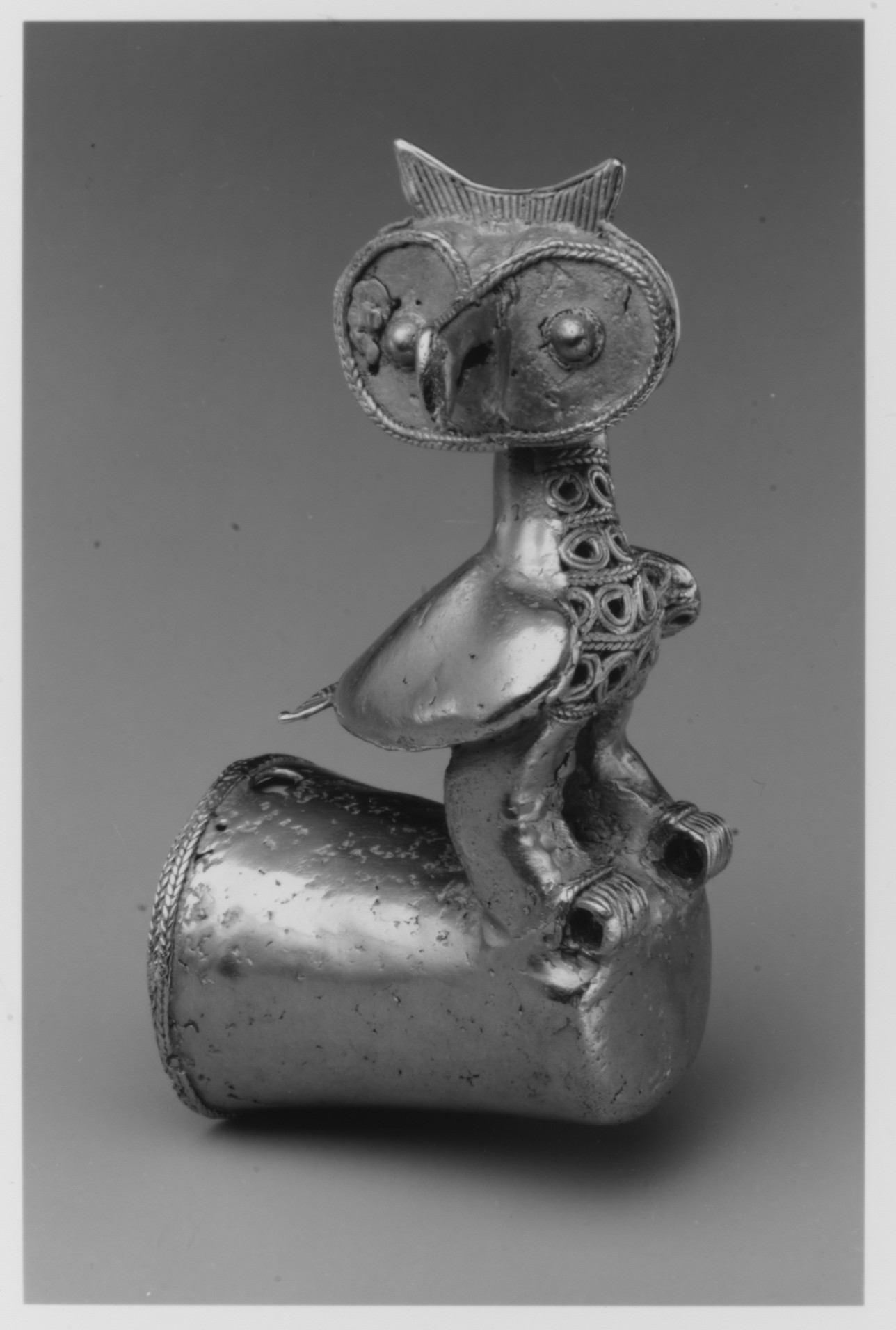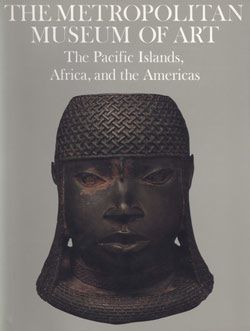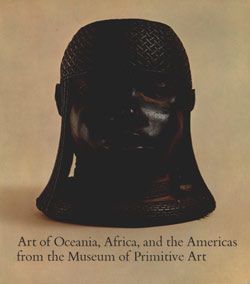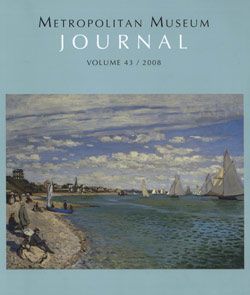Owl Staff Head
Not on view
Thought to fit onto staffs of rank or office, staff heads or finials from the Caribbean Lowlands in northwestern Colombia, have a thimble-shaped cap topped with three-dimensional figures of birds, locally known animals, and humans. The small sculptures are often ornate and detailed, as is this owl sitting at the edge of the cap. Its broad head, turned at a right angle to its body, has circular eyes and a pronounced beak; it is framed by a braided element and topped by a ridged crest. The bird's chest is composed of cast filigree openwork, creating a contrast to the polished wings.
Technical Details
This object was made by lost wax casting with cores, which would have been located in the staff head’s base and in the head, neck, and body of the owl, but were mainly removed after casting. (For more information on lost wax casting, please see Metropolitan Museum of Art 2008.569.13a, b). The bird’s body and neck are mostly hollow, and its head may be as well—the mouth is open but it appears there is core material inside the head. On the underside, there is a white material filling in some of the interstices, and this also may be core material.
The elliptical opening at the top of the base, near its back, may have been used to help secure the object to the wooden staff to which it was once joined, potentially using pins that were inserted through the perforated metal and into the wood, according to Falchetti (1995, 37). The interior surface of the base is rough, contrasting with the polished exterior surfaces. The feet of the owl become suspension loops—the proper left loop was originally made of 8 threads of wax and the proper right loop was made of 7 threads. The tops and sides of these loops are outlined by a braided design, each design originally made by plaiting four threads of wax. The front of the bird and the underside are composed of alternating registers of cast filigree braided designs and repeating circles. Again, each braided design (five on the front of the bird, and two on the underside) is made of four plaited threads of wax. The orientation of the braiding is the same on four of the five registers on the front, but the second register from the bottom points in the opposite direction. The orientations of the two on the underside are opposite each other. In the other registers, each circle is composed of two concentric threads of wax. There are four registers of circles on the front and three on the underside. They were designed to span the width of the bird in different locations, and so, like the case of the topmost register of circles, there may be circles at the far edges that are not complete. The circumference of the base, at the open end, shows a braided design that was made of two rows of plaited threads of wax. Each row was made by plaiting four threads, and the orientation of the braiding is the same between the rows.
The owl’s tail was made by joining six bands of wax with six other bands, at a 90-degree angle, and then likely cutting them at a 45-degree angle to form the back end of the tail, adding a small stub of wax to fill the triangular space at the back center. A braided design wraps around the head and onto the beak of the owl. This was made by plaiting four threads of wax. Around each eye there is a braided design, too—this is extremely detailed work, given the small size of the braids. The crest on the owl’s head was made by joining approximately 27 bands of wax and then outlining them with a thin band. All of these different joins would have been accomplished by applying light heat and/or pressure to the wax during the construction of the wax model. There is a large metal extrusion near the owl’s proper right eye that may relate to incomplete investment, the ceramic material shaped around the wax model that the artists designed to control the regions to which the molten metal spread during casting. Leaving this addition in place, rather than removing it, may have been a choice of the artists, a reminder of the labor that went into the staff head’s fabrication.
This staff head is part of the group of Zenú metalwork defined by scholars as "staff heads" ("remates de bastón") (see Falchetti (1995, 37, figs. 1-4). Specifically, this object is part of Type 1 under Falchetti’s classification. In this type, staff heads show animal figures, particularly single birds, and are between 6 and 12 cm high, two features that align with the present example. Staff heads of this type tend to be made of gold or an alloy of gold and copper with high gold content and may show depletion gilding. In this process, copper is oxidized from the surface of the alloy with the application of a corrosive paste or solution, and then the object is pickled to remove the oxide scale, thereby enriching the surface in gold. Type 1 staff heads have been recovered from a range of locations in the Zenú landscape, from the basins of the San Jorge, lower Cauca, and Nechí Rivers (Falchetti 1976, map 14; Falchetti 1995, table 1), suggesting the importance of birds in Zenú iconography. Zenú settlements and the production of metalwork appear to have been concentrated in the Momposina Depression between A.D. 500 and A.D. 1000 but there is early Zenú metalwork between A.D. 1 and A.D. 500 in the area of the lower San Jorge River, along with the valleys of the lower Cauca and Sinú Rivers (Falchetti 2000, 136).
Spanish colonists raided Zenú settlements starting in A.D. 1515 (Falchetti 1995, 14) and their accounts describe some works in metal in their original contexts. For example, with respect to staff heads, there are references to "spears with tips of gold" ("dardos con hierros de oro") that were buried with people and found in temples, and to figural sculptures in wood, set up in temples, that depict some of the same figures shown on staff heads (Falchetti 1995, 37-38). Considering these sources, we can infer that these metal staff heads, or at least the iconography that is often a part of them, as Falchetti suggests, played a role in configuring funerary settings and other sacred locations in Zenú settlements (please see Serpa 2000, 93-98 for more information on Zenú funerary contexts).
The presence of loops at the owl’s feet suggests that people also employed the object as a pendant, with or without a wooden staff attached to it. These loops are an unusual feature on the staff heads—this is the only example I have seen that includes them, suggesting that the artists who fabricated this staff head had aims for this object that were distinct from those behind the fabrication of other, similar objects. Such suspension loops at the feet of an animal are prevalent on a range of other metal figurines from northern Colombia and the Central American Isthmus (please see Metropolitan Museum of Art 1974.271.16 for more information). Some Zenú people today, especially in San Andrés de Sotavento, conceive of the universe as being comprised of three layers, with humans in the middle layer and spirits related to animals above and below (Turbay and Jaramillo 1998). If owls and other avian fauna, with the exception of water birds (see Falchetti 2000, 138), are part of the upper layer, it is an open question of how their role in the universe was reflected in the fabrication and use of this staff head—is the owl landing on the staff head’s base and the wooden staff? How does the owl relate to the person or material from which the staff head was suspended, if the loops at its feet were used? There has been some work to recognize the lineage of Zenú metalworking in communities like Mompós (Lobo 2014) but without yet delving into such questions of interpretation and interactions between ornament and body.
For further context on the archaeology of the Zenú region, please see Metropolitan Museum of Art 1979.206.542 and 2005.409.1a, b.
Bryan Cockrell, Curatorial Fellow, Arts of Africa, Oceania, and the Americas , 2017
References
Emmerich, André. Sweat of the Sun and Tears of the Moon: Gold and Silver in Pre-Columbian Art. New York: Hacker, 1977, p. 80, fig. 91.
Falchetti, Ana María. The Goldwork of the Sinu Region, Northern Colombia. MPhil diss., University of London, 1976, fig. 30.5.
Lapiner, Alan. Precolumbian Art of South America. New York: Harry N. Abrams, Inc., 1976, p. 388, no. 828, ill.
The Metropolitan Museum of Art. The Pacific Islands, Africa, and the Americas. New York: The Metropolitan Museum of Art, 1987, p. 138, no. 103, ill.
Newton, Douglas. Masterpieces of Primitive Art- the Nelson A. Rockefeller Collection. New York: Alfred A. Knopf, 1978, p. 216, top illustration.
Exhibition history
Los Angeles, Los Angeles County Museum, "Gold Before Columbus," Mar. 19 - May 15, 1964, cat. no. 148, ill on p. 51
New York, Museum of Primitive Art, "Masterpieces from the Americas," May 20–Nov. 11, 1964
New York, Museum of Primitive Art, "Techniques and Materials of Primitive Art," July 22–Oct. 23, 1966
New York, Metropolitan Museum of Art, "Art of Oceania, Africa, and the Americas from the Museum of Primitive Art," May 10–Aug. 17, 1969, cat. no. 465, ill
TV-NBC, program taped at Metropolitan Museum of Art, Jan. 20, 1970, with Aline Saarinen in celebration of Metropolitan Museum of Art Centennial
New York, Museum of Primitive Art, "Birds, Beasts, and Fantastic Creatures from the Museum Collection," June 17–Sept. 13, 1970; Leningrad, Hermitage Museum, "Gold of Precolumbian America," Aug. 4 –Oct. 1, 1976
Moscow, The State Museum of Representational Arts, Oct. 15 –Dec. 15, 1976; The Kiev State Historical Museum, Jan. 5 - Mar. 1, 1977, p. 122, cat. no. 92, ill.
Further Reading
Falchetti, Ana María. The Goldwork of the Sinu Region, Northern Colombia. MPhil diss., University of London, 1976.
———. El oro del Gran Zenú. Bogotá: Banco de la República, 1995.
———. "The Gold of Greater Zenú: Prehispanic Metallurgy in the Caribbean Lowlands of Colombia." In Precolumbian Gold: Technology, Style and Iconography, edited by Colin McEwan. London: British Museum Press, 2000.
Lobo, Jimena. "Changing Perspectives: The Archives of Memory and Material Culture." Archaeological Review from Cambridge 29, no. 2 (2014): 69-87.
Turbay, Sandra and Susana Jaramillo. "Los indígenas Zenúes." In Geografía humana de Colombia: Región Andina Central IV, 3. Bogotá: Instituto Colombiano de Cultura Hispánica, 1998.
Due to rights restrictions, this image cannot be enlarged, viewed at full screen, or downloaded.
This artwork is meant to be viewed from right to left. Scroll left to view more.







